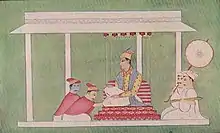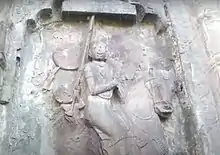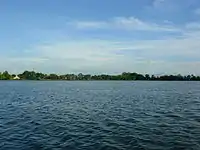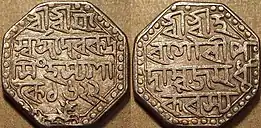Sukhrungphaa
Sukhrungphaa (reigned 1696–1714), or Swargadeo Rudra Singha, was a Tungkhungia king of the Ahom kingdom under whom the kingdom reached its zenith of power and glory. Rudra Singha, known as Lai before he became the king, was the son of the previous Ahom king Gadadhar Singha. An illiterate (probably dyslexic), he is best known for building a coalition of rulers in the region and raising a vast composite army against the Mughal Empire. He died on the eve of his march west from Guwahati.
| Sukhrungphaa | |||||||||
|---|---|---|---|---|---|---|---|---|---|
| Chaopha Swargadeo of Ahom Kingdom | |||||||||
 Rudra Singha receiving the kings of Jayantia and the Kachari kingdoms in his court | |||||||||
| Ahom King | |||||||||
| Reign | 1696 CE to 1714 CE | ||||||||
| Predecessor | Supatphaa | ||||||||
| Successor | Sutanphaa | ||||||||
| Born | 1665 Ahom kingdom | ||||||||
| Died | 1714 Ahom kingdom | ||||||||
| Issue | |||||||||
| |||||||||
| House | Tungkhungia | ||||||||
| Dynasty | Ahom dynasty | ||||||||
| Father | Gadadhar Singha | ||||||||
| Mother | Joymoti Konwari | ||||||||
| Religion | Hinduism | ||||||||

.jpg.webp)
| Ahom dynasty | ||||||||||||||||||||||||||||||||||||||||||||||||||||||||||||||||||||||||||||||||||||||||||||||||||||||||||||||||||||||||||||||||||||
|---|---|---|---|---|---|---|---|---|---|---|---|---|---|---|---|---|---|---|---|---|---|---|---|---|---|---|---|---|---|---|---|---|---|---|---|---|---|---|---|---|---|---|---|---|---|---|---|---|---|---|---|---|---|---|---|---|---|---|---|---|---|---|---|---|---|---|---|---|---|---|---|---|---|---|---|---|---|---|---|---|---|---|---|---|---|---|---|---|---|---|---|---|---|---|---|---|---|---|---|---|---|---|---|---|---|---|---|---|---|---|---|---|---|---|---|---|---|---|---|---|---|---|---|---|---|---|---|---|---|---|---|---|
 | ||||||||||||||||||||||||||||||||||||||||||||||||||||||||||||||||||||||||||||||||||||||||||||||||||||||||||||||||||||||||||||||||||||
|
||||||||||||||||||||||||||||||||||||||||||||||||||||||||||||||||||||||||||||||||||||||||||||||||||||||||||||||||||||||||||||||||||||
His father had to escape persecution by the previous Ahom king and his mother, Joymoti Konwari, was killed in royal custody. He established his capital at Rangpur.
Reign
Political works
Though he was himself illiterate, he had an expansive and progressive political vision, just as Akbar had. Rudra Singha subjugated the Dimasa (1706) and Jaintia kingdoms.[1] His father had removed the last vestiges of Mughal rule in Assam, and he planned to extend his kingdom up to the Karatoya River, the traditional western boundary of the erstwhile Kamarupa kingdom. He began forming an alliance with different kingdoms and positioned himself at Guwahati for the expedition with a large army and fleet, along with the troops from the Dimasa-Kacharis (14,000), the Jaintiyas (10,000) and the Daflas (600) collected all the cannons, and raised a total army of 4 lakhs troops when he died. The later kings did not follow up on his plans. Rudra Singha reversed the persecution of the Vaishnava xatras during Gadadhar Singha's reign and reinstated the xatra preceptors, including Chaturbhujdeva the satradhikari of Mayamara xatra, in their former seats.[2] But he forbade the sudra satradhikars from initiating Brahmins and Brahmins from vising sudra monasteries, under the influence of the gosain of Auniati xatra who was the royal perceptor.[3] It is also said that he subjugated all the hill tribes
Administrative works
He encouraged exchanges with other kingdoms and sent ambassadors to other royal houses in various parts of India. He created khels or official positions specifically for diplomacy, like Khaund, Kotoki, Bairagi, Doloi, Kakoti. He sent men to Delhi to learn music and Brahman boys to Gurukuls for Vedic and Sanskrit studies. He brought architects from outside for constructing the palace and other buildings in the new capital city, Rangpur. He introduced Mughal style dresses in the Ahom court. He encouraged the culture of local folk music and dance and appointed officers called Gayan Baruas. It is said that he was the first Ahom king to have the Bihu celebrated in the courtyard of the palace.
As he grew older, he felt more and more drawn towards Saktism and decided to become a sakta. However, he died before his initiation could be completed. He instructed his sons to invite the Bengali priest Krishna Ram Bhattacharyya and accept him as their religious guide.

Civil works
- In honour of the memory of his mother Joymoti Konwari, he dug the Joysagar Tank, India's largest man-made tank covering an area of 318 acres (1.29 km2), including its four banks.
- In 1703, he built the Ranganath (Shiva) Temple near the Borduar, or main gateway, on the way from the Joysagar Tank to the Talatal Ghar - for the offering of prayers to Shiva.
- Before the Ranganath Dol, a pyramid-shaped temple was constructed in 1703–04, to perpetuate the memory of his mother Joymoti Konwari: this marked the "Maidam" of Joymoti.
- Numerous other architectural monuments and structures are credited to him, including the Namdang stone bridge of Gaurisagar, and the Kharikatia Ali (ali meaning road in Assamese) - leading from Kharikatia to Titabor. The Namdang bridge, a stone bridge 60m long, 6.5m wide, and 1.7m thick was built over the Namdang River in 1703. It is one of the best examples of the engineering workmanship and skill of the Ahom era. This bridge, on National Highway no.37, has been proudly providing service for the last 300 years.
Proposed Invasion of Bengal
Rudra Singha subjugated the Kacharis and Jaintiyas. Who had become virtually independent during the period of the Mughal war in 17th century. He then began to make elaborate preparations for a fresh war against Mughals with two ends in view namely, to oust them from their sovereign power in eastern India and to expand their territory to the Ahom kingdom as far as the Karatoya river to the west.Conveying a meeting with nobels and officers, the king expreesed his desires thus: "Well, I intend to invade the territories of lying between the boundaries of Dacca and Rangagara. What is your oppinion"? The Barpatra Gohain supported the king proposal and said: "The king's proposal is reasonable .The territories bordering on the karatoya are ours. The enemies have got possession of them only on account of our indifference and inaction. The duty of the king is to destroy the enemy and to recover the lost possession with a view to preserving the ancient boundaries of his kingdom. We have a large fleet and naval soldiers and abundance of war-materials. If the king orders, the enemy will be crushed and destroyed. The Barpatra Gohain was supported by Buragohain. But the king, who perhaps expected more inspiring words from the ministers was not satisfied with their tacit approval words from the minister and got angry and dismissed them. At this the phukans and the Baruas came to support and said, Oh king, you can dispense with the Gohains; command us and we shall attack the territories up to the boundaries of Decca. Rudra Singha was also was not to be discouraged.He carefully thought of his plan to create a opinion among the Hindu Rajah outside Assam. He invited scholars and artist, musicians and artisans and religious men and medicants with due honour and sent monetary presents to those scholars and brahmans, who couldn't come so far to Assam. He also attempted to organise a confederacy of the Rajas of Hindustan and sent messages to several Rajas and Zamindars, including that of Amber. The Kachari and the Jayantia Rajas along with Daflas of north hills, total mobilised a strong army which total numbered 4,000,00. But just before the expedition could start the king died, his immediate descendants didn't follow up on his plans.[4]
Hindu proclivities
His Hindu proclivities increased as he grew older, he decided to embrace and to become an orthodox Hindu. He summoned Krishnaram Bhattacharjya a famous mahant of sakta sect. The mahant was first unwilling to come, but consented when promised to take care Kamakhya Temple. When Mahant arrived the king changed his mind to become his disciple, the priest departed with high offence. At this moment several earthquakes occurred which shattered many several temples, Rudra Singha seeing the phenomenon as an indication of Mahant was real favourite of Gods, hastened to recall him. He instructed his sons and brahmans to accept the Mahant as their Guru. [5]Ahom priests who were still actively engaged in attempts to persuade the king to organize expensive Ahom-style state rituals in order to avert predicted dangers , but there is no sign that they were successful. In the first decade of the eighteenth century the Ahom priests took the rather desperate measure of cursing him for neglecting his ancestral religion and culture[6]
Patronage of Cultural Activities
Since the days of Bamuni Konwar, Sanskritization or Araynization of the gained momentum and reached it's peak during Rudra Singha and Siva Singha.Whether in the form of Sakta ritual or in the form of Ekasarana Dharma, the Ahoms kings were receiving increasing dozes of Aryanism. Rudra Singha, being helped by the material conditions of the time, acted more vigorously in the line with his tradition. Now, in the order consolidate the Ahom monarchy in the force of growing feudal forces leading the Neo-Vaishnavite movement, Rudra Singha had to look up for friends among feudal rulers elsewhere in India and to secure a place of confederacy of them, thereby integrating the Ahom ruling class with the Indian ruling classes, including the Mughals.[7] He introduce Mughal dress to Ahom court and sent Brahman boys to study at great centres of learning un Bengal and Bihar[8] He did not fail to patronise local art and culture. He encouraged the culture of local music and dance and for this he appointed officers like Gyan Barua. It is said that it was he,who for the first time had the Bihu celebrated in the palace courtyard and organised varied performances for full seven days including competitions of many kinds or sports and games and cultural shows[9] For the promotion of sports and games he created offices like those of Sen-chowa Barua, who was in charge of training of hawks and Kukura-chowa Barua, in charge of training of cocks.
Kabiraj Chakravarty
There were numbers of poets and scholars in his court. Of them the most notable was Kabiraj Chakravarty, who composed the famous drama Sankha-Chuda-Bandha, and had also translated many books and purans into assamese.[10]
Death
An interesting story revolves around his death as per the buranjis. On the 12th day of Aghun the king seized by a dangerous disease. He had flattered himself daily with hope of seedy recovery, a month passed without smallest improvement of his health. He made charitable donation on all the temples of in the neighbourhood. His pious offering to Kamakhya Temple were twelve buffalos,hundred goats, hundred and fifty pigeons, 200 rupees, twenty tolas of gold and many land grants. For the temple of Hayagriva Madhava Temple he bestowed a large golden vessel, two hundred rupees, thirty tolas of gold. His pious dristibutive donation's went in vain. Mukali Muriya Bhattacharya was appointed, he Bhattacharya desired permission to offer his devotions in the temple of Bhubaneswaree Devee and promised compliance with his order on the ensuing day. Bhattacharya repaired to the temple with rich presents from the King and after performing the usual devotions became absorbed in the Dyan. In this attitude his person was soon covered with worms which had crawled from the earth, yet his attention was rivetted on the object of his contemplation. Devee stood before him in the form of a Tiger, yet he altered not his attitude, nor betrayed the slightest emotion of fear. She assumed the figure of a man and threw him forcibly to a considerable distance out of the temple; he rose, returned and recommenced the Dyan. The Goddess now seized and hurled his person into’ the shallow water below; again he ascended the temple and resumed his devotions. Devee at last, appeared before him in the shape of a beautiful woman; expressed her curiosity to be informed of the motives of his absolute perseverance after the trials to which she had subjected him. “ If my devotions ” answered the Bhattacharya “ have proved acceptable to you, acquaint me with the event of the Monarch’s indisposition and the period of his death or recovery.” Takooranee informed him that the King would expire on 14th of pooh, in the noon.The Bhattacharya entreated the same information relative to the duration of his own life as a reward for his constant devotion at her alter and received her orders to return to the place of his residence where he might expect the fatal hour at the expiration of a year. the Goddess vanished. The Bhattacharya repaired to the presence of the King and offering up his prayers, pronounced the news of the Monarch’s approaching death at the end of three days.The King asked if the information was true.The Bhattacharya replied that he could no further answer for the reality of the sentence than that he received it from Takooranee. The three Gohains, the Borbarua and Borphukan were immediately called before the Monarch and informed of the approaching period of demise.[11]
Death bed injuction
Take your seats, remain in friendship; You will thus all become Monarchs in your turns. Noting will succeed if you are inimical to one another. If any attempts are made to place you at variance and many will be made, listen not to suggestion of that kind, but remain united. I had formerly two brothers, but listening to the suggestion of enemies, I drove away the younger. I now precive my error; continue therefore in friendship, and all your pursuits will succeed; if you prove enemies, nothing. Old and young, you shall all be Kings successively. I have subdued the countries that surrounded my dominions; I proposed the reduction of the provinces contiguous to the Karatoya river: but my design must perish with me, for who will be found capable to pursue my plans?”[12]
Character and Legacy
The most striking events of his reign, which extended over seventeen eventful years, were the war against the Kachari and Jaintia kings. Although illiterate, Rudra Singha was possed with of retentive memory and of exceptional intelligence. He is regarded as the greatest Ahom King. It is also said that he received the submission of all the tribes, and to have established trade with Tibet. Abandoning the policy of isolating the policy of his predecessor to some extent, he encouraged intercourse between the different countries and sent envoys to them of India. He studied foreign customs and adopted those he thought was good. He imported many artificer from Bengal, and also established many school's for Brahmans.[13]
Descendants
- Rudra Singha
- Siva Singha
- Ugra Singha
- ??
- Ugra Singha
- Pramatta Singha
- Molou Gohain
- Madhab Gohain
- Barjana Gohian alias Mohanmala Maladev Gohain
- ??
- Rajeswar Singha
- Ratneswar
- Bijoy Bormura
- Brajanath
- Bijoy Bormura
- Ratneswar
- Lakshmi Singha
- Siva Singha
Notes
- Baruah, Swarnalata . Comprehensive History of Assam, 1986, p. 291.
- Baruah 1993, p55
- Baruah 1993, pp55-56.
- Baruah 1993. pp. 290–291.
- A history of Assam. Thacker, Spink & Company, 1906. 1906. p. 182. ISBN 9780404168193.
- Gogoi, Padmeswar (1968). Padmeswar Gogoi 1968. p. 508.
- Comprehensive history of Assam, SL Baruah. p. 292.
- G.R. Barua. p. 93.
- L.Gogoi, Ahom Jati aru Asamiya Sanskriti. p. 16.
- Comprehensive history of Assam, SL Baruah. p. 293.
- Wade, John Peter,An Account of Assam. R. Sarmah, Assam. pp. 184–185.
- Wade, John Peter,An Account of Assam. R. Sarmah, Assam. p. 136.
- A history of Assam. Thacker, Spink & Company, 1906. 1906. p. 181. ISBN 9780404168193.
- Barua 1993. pp. 286–287.
References
- Baruah, S L (1993), Last Days of Ahom Monarchy: A History from 1769 to 1826, Munshiram Manoharlal Publishers Pvt Ltd, New Delhi.
- Gait, Sir Edward (1905), A History of Assam, LBS First Edition, 1983, LBS Publications, Guwahati.
